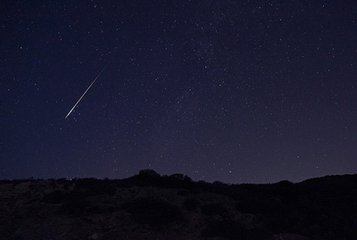(单词翻译:单击)
Squeaks and I built this awesome observatory recently, and we love using it to look at the night sky!
我和吱吱最近建了一个很棒的观测台,我们喜欢用它看夜空。
If you've ever looked up on a dark, clear night, you probably noticed that there are a lot of things to see.
如果你曾在一个漆黑晴朗的夜里仰望天空,你会发现那里有好多东西。
You can see the Moon, the stars, and even some planets!
你能看到月亮、星星甚至是一些行星。
And if you're really lucky, you might even get to see a meteor: a streak of light that bursts across the sky.
如果你真幸运的话,你甚至能看到一颗流星,即滑过天空的光迹。
Since the light that meteors make looks kind of like the bright light that stars make, a lot of people call meteors "shooting stars".
因为流星制造的光有点儿像明亮的星光,所以许多人称它为“射星”。
But meteors aren't stars at all!
但是流星根本不是星星!
Stars are big balls of gas way out in space, far, far away from the Earth.
星星是太空中巨大的气状天体,离地球很远很远。
But meteors are caused by pieces of rock and metal that are pulled close to the Earth.
但流星是由受地球牵引靠近的岩石和金属碎片引起的。
It all starts when a small piece of rock or metal breaks away from something bigger in space.
它开始是太空中大块岩石或金属脱落下来的一小块物质,
Most of the time, these pieces are small, not much bigger than a grain of rice.
大多时候,这些碎屑很小,不比米粒大多少。
And some are only about the size of a piece of dust!
有些只有一粒灰尘那么大。
When the pieces fall toward Earth, they're going so fast that they heat up all the air around them and burn up, making the air glow.
当这些碎片落向地球时,它们的速度非常快,以致于把周围的空气都加热燃着了,让空气发出耀眼的光芒。
That's the light that we see in the sky, it's a little piece of rock or metal burning up!
这就是我们在天上看到的光,它是一点儿岩石或金属碎片燃烧的结果。
We call the falling piece a meteoroid, and the light it makes is the meteor.
我们称坠落的碎片为流星体,而它发出的光就是流星。
When the meteoroid is completely burned, the meteor is gone, and the light disappears.
当流星体被完全烧毁时,流星消失了,光亮也消失了。
If the piece is very small, the light might only last for less than a second.
如果碎屑非常小,光亮可能只持续不到一秒的时间。
If the piece is larger, though, the streak might race the whole way across the sky!
如果它大些儿,光迹可能贯穿整个天空。
And if the piece is large enough, it can make it all the way through the layer of gases around the Earth...and hit the surface of the Earth.
如果它足够大的话,会一直穿过地球的大气层,砸到地球表面。
If it does, then it gets a new name...a meteorite.
如果真这样,它会有一个新名字,即陨星。
I know! That's a lot of words that sound almost the same.
我知道。好些单词听起来几乎是一样的。
But they're all different: the meteor is the streak of light,
但它们完全不同:流星是光迹,
the meteoroid is what we call the bit of rock or metal as it falls, and the meteorite is what we call it when it hits the ground.
流星体是坠落的小块岩石或金属,陨星是它撞击地面时的称呼。
Thousands of meteorites fall to the ground every year, but most of them are really small, so we don't notice them!
每年成千上万的陨星坠入地面,但大部分非常小,所以我们没注意到。
And there are even more meteoroids that burn up before they can get to the ground.
甚至更多的流星体在到达地面之前就烧起来了。

During certain times of the year, there are a lot more meteors than usual.
在一年的某些时间里,流星会比平时多得多。
There can be 60 of them in an hour!
每小时甚至有60颗!
That's called a meteor shower, because there are so many meteors falling through the sky that it's almost like we're taking a shower in them!
这被称为流星雨,因为这么多的陨星从天上掉下来,就像我们在里面淋浴一样!
I know, that is kind of funny!
我知道,这有点儿滑稽!
Can you imagine taking a shower in falling rocks and dust?
你能想象在掉落的岩石和灰尘里淋浴的情景吗?
I think I'd rather stick to water instead.
我想我还是会坚持水浴的。
Meteor showers happen because of something else in outer space, called a comet.
流星雨的发生是由外太空的其他物质,一种叫做彗星的天体引起的。
Comets are usually very far away from the Earth, all the way out at the edge of the solar system.
彗星通常离地球很远,它一直在太阳系的边缘。
But sometimes one passes close by, right near the path where Earth moves around the sun!
但有的时候,它路过时,恰好接近地球绕太阳旋转的轨道。
As it passes by, some dust from the comet breaks off, and the dust can stay in that spot for a really long time.
彗星经过时,一些灰尘从上面脱落下来,这些灰尘在脱落地点能停留很长一段时间。
Every year, when the Earth is close to the spot where the dust is,
每年,地球靠近灰尘的脱落地点时,
lots of the dust falls toward Earth, and each little piece of it creates a meteor.
许多灰尘落向地球,每一粒灰尘都是一颗流星。
And that's when we get a meteor shower!
因此,我们看到了流星雨!
There are a few different meteor showers all throughout the year.
全年会有几场不同的流星雨。
There are big ones in January, April, May, July, August, October, November, and December, so there are lots of chances to see them!
1月、4月、5月、7月、8月、10月、11月和12月的流星雨较大,所以有许多观看的机会!
In fact, Squeaks and I are just about to get to see one of the biggest meteor showers of the year, called the Perseids.
事实上,我和吱吱正准备去看一场最大的流星雨,即英仙座流星雨
The best nights to see it are right around August 12.
看它的最好夜晚是在8月12日左右。
You can ask a grownup to help you find out when you'll next be able to see a meteor shower.
你可以让一个成年人帮你查查下次的流星雨是什么时候。
Then, all you need to do is to find a dark spot, look up...and enjoy the light show!
然后,你只需要找个黑暗的地方,仰头享受流星雨的表演!
Have you ever seen a meteor? How about a meteor shower?
你看到过流星吗?流星雨呢?
Ask a grownup to help you leave a comment below, or send us an email at kids@scishow.com.
找个大人帮忙在下方留言,或发邮件至kids@scishow.com!
Thanks, and we'll see you next time! Here the Fort!
感谢您的收看,我们下期见!沃斯堡等你哦!


